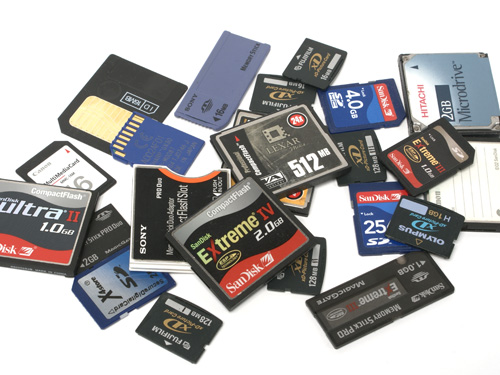
One of the greatest fears of a photographer is to attach the memory card to the computer only to find that it has been damaged and all of the images have been lost. To protect against this disaster it is recommended that you test your memory card on a regular basis. This can be done as simply as reformatting the card. Take great care in protecting your memory cards because without them your camera can do nothing but click and beep.
Here are some tips for using and caring for Memory Cards
1. If Disaster Strikes – Stop Shooting
If you have a disaster and accidentally delete your images or see an card error message – stop using the memory card. All is not always lost when you have one of these problems and it may be that you can still recover your images – the key is to stop using the card or else you might overwrite your other images. Data recovery services or tools may be able to restore your images for you.
2. Delete Images on your Computer not In Camera
Deleting images from your card while the card is on your camera can actually prolong the life of your memory card. The rule is that the fewer times you add or remove data on your card the better. Erasing all your images at once after uploading them to your computer means one erase cycle rather than lots of them if you delete them one at a time on your camera.
3. Remove Cards Safely When Connected to Your Computer
After uploading images to your computer from a card make sure you follow the proper procedure to eject the card before removing it from your card reader. In OSX this means right clicking the drive assigned to your card and hitting ‘eject’. In Windows use the ’safely remove hardware’ option in your system tray to remove the card and the card reader).
4. Multiple Cards Can be Better than One
I learned this lesson on a recent trip when I had a memory card die on me mid trip. Having a second card handy meant that I was able to continue using my camera. It also means that if you do lose the data on one card, not all of your images from a shoot will be lost. Of course multiple cards can also mean problems too as there are more to keep track of – I’ve heard h3 arguments for both – but personally rotate through 3 cards at present.
5. Avoid Filling Your Cards Completely
I have a friend who recently had an issue with a memory card. When he took it into the store he bought it from for advice they asked if he’d completely filled the card with images. When he said he had they told him that this could occasionally cause problems with some types of cards. I’d not heard this before and am a little skeptical about it myself – but it’s probably worth keeping in mind. I guess the advice is to regularly take images off your cards rather than doing it just when they are full. This is common sense anyway as it stops the heartbreak of losing gigabytes of images if you lose a card/camera or have a card error with a three quarters full memory card.
6. Periodically Reformat Cards
Every now and again reformat your memory card. This will wipe any data, images, file names on the card and set it up afresh for your camera. Of course you should only do this AFTER you’ve downloaded any images on the card or you’ll lose them.
7. Format your Memory Card In the Camera You Want to Use it on
Formatting your memory card while in your camera will make sure that the card is set up and structured specifically for your camera. If you’re using someone else’s card in your camera (and they’ve used it on a camera with a different make) you can end up with issues that can be resolved by reformatting on your camera (just make sure you’ve got all the images that were on the card off it first as reformatting deletes all data on the card).
8. Switch Your Camera Off before Removing Memory Card
This was a tip that was given a lot a year or two ago for fear of cameras giving cards ‘voltage shock’ on removal of the card. Manufacturers seem to have made improvements in this area since then – although I can’t speak for all of them and I guess that it is better to be safe than sorry. Check your camera manual to see what they recommend.
9. Keep Your Camera Up to Date
Camera manufacturers will release firmware updates from time to time. These keep your camera up to date with any fixes for errors or problems that are identified with a camera. Some of these can relate to the camera’s interaction with the memory card.
10. Periodically Update Your Cards
While memory card life spans have increased significantly over the last few years – they do have a limited life and will need to be updated from time to time. With prices coming down this is fortunately a less and less expensive task.
11. Replace Batteries Before they Run Down
Keep an eye on the power level left in your camera’s batteries and either recharge them or change them over for a fresh set before they completely run down. This will stop your batteries running out halfway through writing an image to your card. This will stop you losing that last image but also can stop card errors that can occur when an image is not fully written to a card.
12. Don’t Switch Off Your Camera too Quickly after Shooting
This tip is for those of us who shoot in ‘burst’ or ‘continuous shooting’ mode. When shooting lots of images quickly a camera needs a little time to write all of the data you’ve taken to the memory card. If you’ve taken numerous images very quickly your camera will be ‘buffering’ images and if you switch it off during this process you’ll lose images and could even find yourself with a system error (note: some more modern cameras have fixed this problem and will now continue buffering after you switch them off).
13. Common Sense Maintenance
It should go without saying – but keep your cards dry and clean, don’t expose them to extreme temperatures, don’t drop, bend or puncture them and don’t expose them to h3 electro/magnetic currents. Storing cards that are not in use in a plastic casing (usually supplied with the card) can give it an extra layer of protection.
[via]




